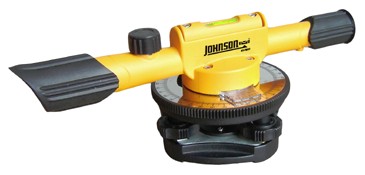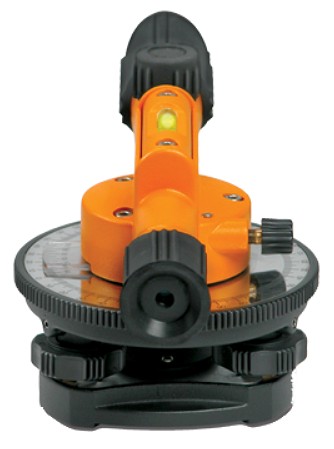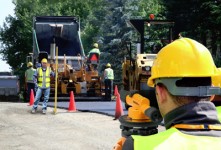Johnson Level & Tool Mfg. Co.,
Inc.
 A
builder's level is used in the construction field to set up level points and
to check elevations. It is an optical instrument used mainly in surveying
and building but is also useful for transferring, setting, or measuring
horizontal levels.
A
builder's level is used in the construction field to set up level points and
to check elevations. It is an optical instrument used mainly in surveying
and building but is also useful for transferring, setting, or measuring
horizontal levels.
The tripod the builder's level is being set up on must
be set on secure ground to get the telescope positioned level.
Also called a "dumpy" level, the
builder's level is inexpensive, easy to
assemble, easy to use and lightweight. There are many parts to a builder's
level, but it is primarily a leveling vial attached to a telescope. The
leveling vial consists of marks called graduations used for centering the
bubble. A builder's level works by attaching the telescope to a leveling
head and finally mounting to a
tripod.
Key Terms
- Benchmark - permanent or fixed
point with a known elevation.
- Height of Instrument - how high
above the bench mark the telescope sits after being leveled.
- Station - definite point between
which lengths are measured. When the instrument is moved, each new
location becomes a station.
- Turning Points - intermediate
points used for transferring a known elevation.
- Backsight - the measurement
taken when the instrument, in the level position, is directed "back"
toward the bench mark. Always recorded as a plus-sight because a
back-sight is always added to the known elevation in order to record
the height of the instrument.
- Foresight - the measurement
taken when the instrument, in the level position, is directed away
from the bench mark. Always recorded as a minus-sight because it is
always subtracted from the instrument height. This new measurement
creates another bench mark.

Parts of a Builder's Level
A builder's level consists of many parts:
- Telescope - holds lenses
which magnify objects in the sight.
- Graduated Leveling Vial -
used to level the telescope on its base.
- Graduated Horizontal Circle
- marked by degrees, used for setting and reading angles.
- Leveling Screws - allows
adjustments to be made to ensure the instrument is level in all
positions.
- Focusing Knob - can be
turned to make object appear crisp and clear.
- Base - area where the
builder's level attaches to the tripod.
- Eyepiece - located at
viewing end of telescope, can be turned to bring the crosshairs into
focus.
- Horizontal Clamp Screw -
holds the instrument in the horizontal position when tightened.
- Horizontal Tangent Screw -
allows the instrument to be adjusted horizontally.
- Vernier Scale - moves when
the telescope is turned to the left or to the right.
Telescope
The telescope is located at the top of the
builder's level. The telescope's main purpose is to magnify distant
objects and make them look nearer. The telescope moves horizontally
around a graduated horizontal circle. The horizontal circle is marked at
each 1 degree up to 360 degrees.
The objective lens sits at the end of the
telescope. It catches the object being sighted and with the help of
other lenses inside of the telescope, the object gets magnified.
At the opposite end of the objective lens sits the
eyepiece where the user looks. Inside the eyepiece, crosshairs run
horizontally and vertically. Rotating the eyepiece allows the crosshairs
to become more focused and clear. There is a focusing knob located on
the barrel of the telescope used to focus crisply on the object being
sighted.
Stadia lines are located on the eyepiece. Stadia
lines are short horizontal lines located above and below the crosshair
that runs horizontally. The stadia lines get bisected by the vertical
crosshairs which allows for the user to find the distance of the object
being sighted.
Level Vial (Graduated Leveling Vial)
Also known as a spirit level, the graduated
leveling vial is used to level the telescope while being placed on the
base. This works much like a traditional hand spirit level.
The base plate of the builder's level is the area
which the level is attached to the tripod. There are three different
kinds of base plates, all with specific instructions for attaching
instruments. When using a threaded instrument base, it can be screwed to
the threaded tripod head. When using either a flathead or a dome head
tripod, there is a center bolt that is located on the bottom of the
tripod that will need to be screwed into the level.
Setting Up and Using a Builder's Level
 When
preparing to set up a builder's level, make sure you have the right
tripod since tripods can have different types of heads.
When
preparing to set up a builder's level, make sure you have the right
tripod since tripods can have different types of heads.
- When using a 5/8" center bolt mount: the
protective cap from the tripod head should be fitted onto any of the
tripod's legs using the attachment found on the cap.
- When using a threaded tripod head mount:
remove the threaded protective cap and set aside. Unthread the level
from the case mount and screw on the tripod head. After being
connected to the tripod head, thread the protective cap onto the
case mount.
Once you have found the correct head for your
instrument, you can start your set up.
Mounting a Builder's Level
Place the level directly on the tripod head after
removing the level from the carrying case. If the level is placed
elsewhere, it could lead to instrument damage. After placing it on the
tripod, the next step is threading or bolting onto the tripod base.
Remove the protective lens covers and put them in the carrying case. You
should also place the sunshade on the telescope. After these steps, the
mounting process is finished.
Leveling a Builder's Level
After mounting your instrument, it is important to
make sure it is level around all 360 degrees to allow for precise and
accurate measurements. Before beginning the leveling process, ensure the
safety and security of your instrument and others.
- Make sure that the tripod is stable and
securely planted before starting the leveling process. It is
important to do this step to make sure the instrument will not tip
over while doing the leveling process.
- Make sure that the attachment between the
builder's level and tripod is secure.
- Make sure the four leveling screws are not
too tight against the leveling base plate.
Procedures: Leveling a Builder's Level
- First position: line up the telescope until
it is located directly over a pair of leveling screws. Using the
leveling screws, center the bubble in the spirit vial.
- Placing both of the leveling screws between
your thumb and forefinger; turn both screws at the same time in
opposite directions and watch for movement in the graduated spirit
vial.
- Move the thumbs together in or out. The
bubble will follow the left thumb.
- Second position: when the bubble is centered,
rotate the telescope 90* (insert degree mark).
- Repeat the thumbs in, thumbs out action
until the bubble is centered in the second position.
- Turn the telescope back to the first position
and make the proper adjustments to ensure that the instrument is
still level.
- Move the instrument through various stages of
the 360* (insert degree mark) and check if the instrument is level
at all points.
Make sure that the instrument is level at all four
leveling points. If it is not level at all points, the final check must
be done again until the bubble is centered at each point. If the bubble
is still not being centered, there may be damages to the leveling
instrument.
Focusing a Builder's Level
After making sure your instrument is level at all
leveling points, the next step is focusing the builder's level.
- The first step in this process is to aim your
telescope at an object. It should look blurry at first, but turning
the eyepiece either left or right should make the object appear
clearer.
- After focusing the eyepiece, point the
telescope directly at the specific target. While keeping the
crosshairs in focus, use the focusing knob to make the specified
object appear sharp.
Marking a Reference Line
 A
level grade line, or reference line, is a sight line that is established
through the telescope. It is created at the horizontal crosshair and
requires two workers to establish.
A
level grade line, or reference line, is a sight line that is established
through the telescope. It is created at the horizontal crosshair and
requires two workers to establish.
- The operator looks through the eyepiece of
the telescope while an additional worker holds a graduated staff or
tape measure vertical at the point under measurement.
- The instrument and staff are used to gather
or transfer elevations during site surveys and building
construction.
- Measurement starts from a benchmark with
known height, or an arbitrary point with an assumed height.
Helpful Hints for Builder's Levels
- When the objective lens is not in use, it should
be covered with a lens cap to prevent damage to the equipment.
- Detachable sunshades are useful in preventing
glare and protecting the objective lens.
- Do not lift your level by the telescope; always
be sure to lift it by the base.
- Make sure to turn both screws at the same time
and rate when leveling a builder's level.
- Make sure the builder's level is level around all
360 degrees of direction; if this is not done, the measurements will be
incorrect.
- Make sure the leveling screws are not too tight -
over tight screws need to be loosened for the most accurate results.
- Do not look at the sun through the telescope.
- Keep both of your eyes open when looking through
the telescope. This will avoid tiring your eyes and eliminate squinting.
- The image being sighted will be sharpest when it
is quartered by the crosshairs. This is the most accurate place on the
lens.
- The jumping of an image is called "parallax".
With each movement, adjust the focusing knob until the image stops
jumping.
- Do not touch the tripod at anytime after the
builder's level is mounted. This can cause problems with the
measurements as well as the accuracy of the level.
- In the case of a threaded base, the instrument
must be unscrewed before it is removed.
- While unscrewing the threaded base, make sure you
hold the instrument with one hand. Also, make sure you hold the
instrument by the frame.
�2010 Johnson Level & Tool Mfg. Co., Inc.

